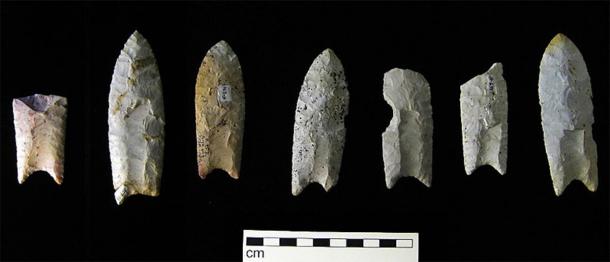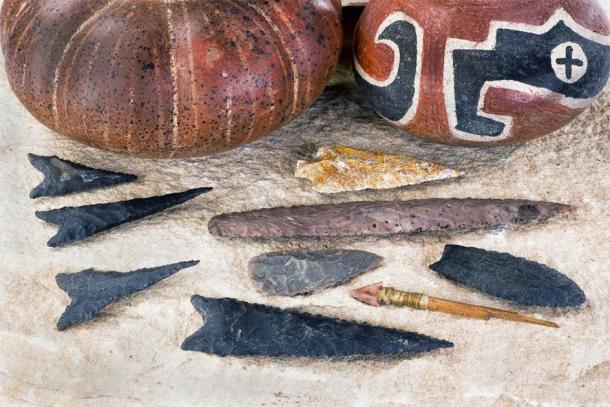While they were not the earliest inhabitants of the Americas, the Clovis people had an extremely significant prehistoric culture that was distinctive and widespread across what is now North America. Clovis tools and weapons, including the iconic Clovis spear point, are easily recognized by almost every North American archaeological student. But new research reveals that Clovis tool manufacturing only existed for about 300 years and fell by the wayside at the same time as the last of the North American megafauna went extinct.
The Clovis culture gets its name from Clovis, New Mexico, where the distinctive stone tools were first identified in 1929. For a long time, researchers believed the Clovis people were the first group of people to make the journey at the end of the last Ice Age into what is now North America, and the age of this culture has been a continued topic of debate. Clovis points are made in jasper, chert, obsidian, and other brittle stones that could be chipped into sharp edged weapons with spear-shaped tips.

Clovis points in the Iowa Office of the State Archaeologist collection . (Billwhittaker/ CC BY SA 3.0 )
But the results of new analysis on bones and other artifacts reveal that Clovis tools were only being made for about 300 years, from 13,050 to 12,750 years ago. This new research comes from Michael Waters, a Clovis expert, Anthropology professor, and director of the Center for the Study of the First Americans at Texas A&M, who teamed up with Texas A&M anthropologist David Carlson, and Thomas Stafford of Stafford Research in Colorado.
The Demise of Clovis Tools and North American Megafauna
ScienceDaily reports that the research team used radiocarbon dating on bone, charcoal, and carbonized plant remains which they obtained from 10 known Clovis sites . Samples were analyzed from South Dakota, Colorado, Pennsylvania, Ohio, Virginia, Montana, and two sites in Oklahoma and Wyoming. The results show that the well-known Clovis points and other Clovis tools were only being made for 300 years. Waters sa ys that the researchers are uncertain “how or why Clovis technology emerged and why it disappeared so quickly.”

Map of the location of dated Clovis sites. ( Waters, M.R., Stafford , T.W. Jr. and Carlson, D. L. / Science Advances )
However, Waters also notes a possible relationship between the Clovis tools and the demise of North American megafauna in a Texas A&M press release . He says:
“It is intriguing to note that Clovis people first appears 300 years before the demise of the last of the megafauna that once roamed North America during a time of great climatic and environmental change. The disappearance of Clovis from the archaeological record at 12,750 years ago is coincident with the extinction of mammoth and mastodon, the last of the megafauna. Perhaps Clovis weaponry was developed to hunt the last of these large beasts.”

Clovis weapons may have been developed to hunt the last of the North American megafauna. ( Daniel /Adobe Stock)
This observation does not mean that the people who made Clovis weapons and tools necessarily died when the megafauna went extinct, it is also possible that they adapted to new hunting methods and created new toolkits to survive in a different environment.
Questioning the Clovis-First Theory
The traditional view about the peopling of the Americas says that during the late Pleistocene period Paleo-Indian people crossed from what is now known as north-east Asia into Alaska via the Beringia land-bridge. The first inhabitants were said to have made this epic journey between 12,000 and 15,000 years ago.
The mark of these people is the aforementioned stone tool known as the ‘Clovis point’ – which archaeologists saw as the sign of people who hunted megafauna. From the 1930s until the 1970s, the Clovis-first theory was the theory about the peopling of the Americas. But then researchers began to make discoveries that were older than they were “supposed to be”, clearly questioning the Clovis-first theory . Thus, the timing and method(s) of the first migration into the Americas became a source of great controversy.
The Texas A&M press release recognizes that the short age range given by this new study for the Clovis culture “does not provide sufficient time for people to colonize both North and South America.” However Waters note s that “Clovis still remains important because it is so distinctive and widespread across North America.”
Prehistoric Toolkits Varied in the Americas
The new study, which is published in the current issue of Science Advances , explains that the revised age for Clovis tools shows it was one of at least three contemporary toolkits “in the Western Hemisphere during the terminal Pleistocene.” Waters says that “Clovis with its distinctive fluted lanceolate spear point, typically found in the Plains and eastern United States, is contemporaneous with stemmed point-making people in the Western United States and the earliest spear points , called Fishtail points, in South America.”

Clovis tools were one of at least three contemporary toolkits in the Western Hemisphere during the terminal Pleistocene. (W.Scott McGill /Adobe Stock)
Even though the Clovis wasn’t the first or only stone tool making group of people living in the region at the time, this culture had a significant impact when they were alive and when archaeologists found signs of their existence thousands of years later. The exact origins and demise of this widespread prehistoric culture are still uncertain , so studies like the current one can provide important clues in solving the riddles.
Top Image: Clovis tools may have been developed to hunt the last of the North American megafauna. Source: Daniel /Adobe Stock
 RSS Feed
RSS Feed















 October 29th, 2020
October 29th, 2020  Awake Goy
Awake Goy  Posted in
Posted in  Tags:
Tags: 













